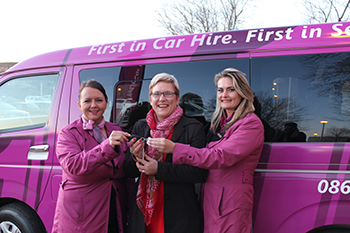Universal Access and Universal Design approach align UFS with international standards

Making mobility for students with disabilities easier, First Car Rental representatives hand over the brand new Toyota Quantum to Hestie Veitch, Head of CUADS.
Photo: Valentino Ndaba |
The Centre for Universal Access and Disability Support (CUADS) launched successfully on 24 July 2015. The objective was “to make more people on campus and from the greater UFS community aware of the services that we provide, and to spread the word about Universal Access.”
“Since the center was founded in 2001, structural and systematic developments have occurred in order to create a welcoming and accessible learning environment that grants students opportunities to be successful in their academic endeavours. Thus, the Unit for Students with Disabilities (USD) has evolved into the CUADS in support of the social model of disability,” said Hetsie Veitch, former Head of the Centre.
Implementing the Universal Access and Universal Design approach has aligned the University of the Free State (UFS) with international standards.
Mingling with the experts
Vendors from across the country displayed their products, and offered demonstrations of functional gadgets and essentials at the event.
Marita Erlank from Sensory Solutions demonstrated how to operate the specialised scanner, which converts printed material to enlarged electronic text and audio, using the Open Book software.
Representing the university’s Sign Language Student Association were Carla Bester, Elrie de Toit and Tebogo Chabangu. To support Deaf Awareness Month (September), theyplan to dedicate a weekto facilitating free workshops for students not registered for the module.
David Greenland and his teamwere also present as part of a Wheelchair Appreciation Month campaign. On 1 September2015,the group of students will raise awareness of the daily challenges faced by mobility-impaired persons by spending the day in wheelchairs.
The day ended on a festive note, by courtesy of the First Car Hire Rental Company. A brand-new Toyota Quantum was handed over as a long-term rental, enabling students of the university to travel between campuses free of charge.
CUADS aims to continue transforming the UFS into a universally-accessible environment by collaborating with internal and external stakeholders. The launch marks a significant step towards Universal Access and Design.